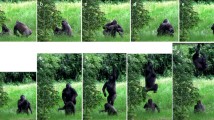Abstract
A subadult male of a captive harem of hamadryas baboons learned, by instrumental trial-and-error learning, to use a tool to supply food for the harem. The behavior did not spread through the harem by imitation. The subadult male's rank in the harem's dominance hierarchy did not change as a result of his tool use.
Similar content being viewed by others
References
Altmann, S. A. &J. Altmann, 1970.Baboon Ecology. University of Chicago Press, Chicago.
Anon., 1970.Menzel reporting on spontaneous use of poles as ladders.Delta Primate Rep.
Bartholomew, G. A. &J. B. Birdsell, 1953. Ecology and the protohominids.Amer. Anthrop. 55: 481–498.
Beck, B. B., 1967. A study of problem solving by gibbons.Behav. 28: 95–109.
Bernstein, I. S., 1970. Primate status hierarchies. In:Primate Behavior (Vol. 1),L. A. Rosenblum (ed.), Academic Press, New York, pp. 71–109.
Birch, H. G., 1945. The relation of previous experience to insightful problem solving.J. comp. Psychol. 38: 367–383.
Bolwig, N., 1961. An intelligent tool-using baboon.S. Afr. J. Sci. 57: 147–152.
——, 1964. Observations on the mental and manipulative abilities of a captive baboon (Papio doguera).Behav. 22: 24–40.
Butler, R. A., 1965. Investigative behavior. In:Behavior of Nonhuman Primates (Vol. II),A. M. Schrier, H. F. Harlow, &F. Stollnitz (eds.), Academic Press, New York, pp. 463–493.
Crook, J. H., 1970. The socio-ecology of primates. In:Social Behavior in Birds and Mammals J. H. Crook (ed.), Academic Press, New York, pp. 103–166.
Darby, C. L. &A. J. Riopelle, 1959. Observational learning in the rhesus monkey.J. comp. physiol. Psychol. 52: 94–98.
Dart, R. A., 1960. The bone tool-manufacturing ability ofAustralopithecus prometheus.Amer. Anthrop. 62: 134–143.
Goodall, J., 1963. My life among wild chimpanzees.Nat. Geog. 124: 272–308.
Hall, K. R. L., 1963a. Tool-using performances as indicators of behavioral adaptability.Curr. Anthrop. 4: 479–494.
——, 1963b. Observational learning in monkeys and apes.Brit. J. Psychol. 54: 201–226.
——, 1964. Aspects of social learning in captive patas monkeys.Primates 5: 59–70.
Harlow, H. F., 1950. Learning and satiation of response in intrinsically motivated complex puzzle performance by monkeys.J. comp. physiol. Psychol. 43: 289–294.
Harlow, H. F., M. K. Harlow, &D. R. Meyer, 1950. Learning motivated by a manipulation drive.J. exp. Psychol. 40: 228–234.
Kawamura, S., 1959. The process of sub-culture propagation among Japanese macaques.Primates 2: 43–60.
Klüver, H., 1933.Behavior Mechanisms in Monkeys. University of Chicago Press, Chicago.
Köhler, W., 1927.The Mentality of Apes (2nd ed.). Routledge & Kegan Paul, London.
Kortlandt, A., 1966. On tool-use among primates.Curr. Anthrop., 7: 215–216.
——, 1967. Experimentation with chimpanzees in the wild. In:Neue Ergebnisse der Primatologie D. Starck, R. Schneider, &H. J. Kuhn (eds.), Gustav Fischer Verlag, Stuttgart, pp. 208–224.
——, 1963. Protohominid behaviour in primates.Symp. zool. Soc. Lond. 10: 61–88.
——, 1969. The present state of research on the dehumanization hypothesis of African ape evolution. In:Proceedings of the Second International Congress of Primatology (Vol. 3),H. O. Hofer (ed.), S. Karger, Basel, pp. 10–13.
Kummer, H., 1957. Soziales Verhalten einer Mantelpavianengruppe.Beiheft 33 Schweiz. Z. Psychol., Verlag Hans Huber, Bern/Stuttgart.
——, 1968.Social Organization of Hamadryas Baboons. University of Chicago Press, Chicago.
——, 1965. A comparison of social behavior in captive and wild hamadryas baboons. In:The Baboon in Medical Research H. Vagtborg (ed.), University of Texas Press, Austin, pp. 65–80.
Lancaster, J. B., 1968. On the evolution of tool-using behavior.Amer. Anthrop., 70: 56–66.
Lawick-Goodall, J. van, 1968. The behaviour of free-living chimpanzees in the Gombe Stream Reserve.An. Behav. Mono. 1: 161–311.
Meier, G. W., H. C. Wilcoxin, R. Orlando, &D. C. Paulson, 1969. The development of food-reinforced behaviors in a social situation. In:Proceedings of the Second International Congress of Primatology (Vol. 1),C. R. Carpenter (ed.), S. Karger, Basel, pp. 143–148.
Menzel, E. W., 1966. Responsiveness to objects in free-ranging Japanese monkeys.Behav. 26: 130–150.
——, 1970. The development of tool-using in wildborn and restriction reared chimpanzees.Folia primat., 12: 273–283.
Parker, C. E., 1969. Responsiveness, manipulation and implementation behavior in chimpanzees, gorillas and orangutans. In:Proceedings of the Second International Congress of Primatology (Vol. 1),C. R. Carpenter (ed.), S. Karger, Basel, pp. 160–166.
Reynolds, G. S., 1968.A Primer of Operant Conditioning. Scott, Foresman, Glenview, Ill.
Rumbaugh, D. M., 1969. The transfer index. An alternative measure of learning set. In:Proceedings of the Second International Congress of Primatology (Vol. 1),C. R. Carpenter (ed.), S. Karger, Basel, pp. 267–273.
——, 1970. Learning skills of anthropoids. In:Primate Behavior (Vol. 1),L. A. Rosenblum (ed.), Academic Press, New York, pp. 1–70.
Schiller, P. H., 1957. Innate motor action as a basis for learning. In:Instinctive Behavior C. H. Schiller (ed.), International Universities Press, New York, pp. 264–287.
Stephenson, G. R., 1967. Cultural acquisition of a specific learned response among rhesus monkeys. In:Neue Ergebnisse der Primatologie D. Starck, R. Schneider, &H. J. Kuhn (eds.), Gustav Fischer Verlag, Stuttgart, pp. 279–288.
Tobias, P. V., 1965.Australopithecus, Homo habilis, tool-using and tool-making.S. Afr. Archeo. Bull. 20: 167–192.
Washburn, S. L., 1960. Tools and human evolution.Sci. Amer. 203: 62–75.
Yerkes, R. M. &A. W. Yerkes, 1929.The Great Apes. Yale University Press, New Haven.
Zuckerman, S., 1932.The Social Life of Monkeys and Apes. Routledge & Kegan Paul, London.
Author information
Authors and Affiliations
About this article
Cite this article
Beck, B.B. Tool use in captive hamadryas baboons. Primates 13, 277–295 (1972). https://doi.org/10.1007/BF01730574
Received:
Accepted:
Issue Date:
DOI: https://doi.org/10.1007/BF01730574




